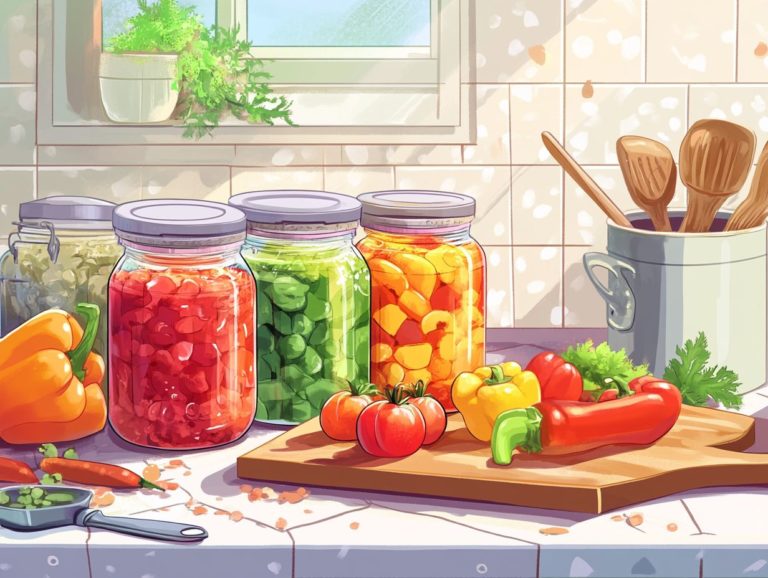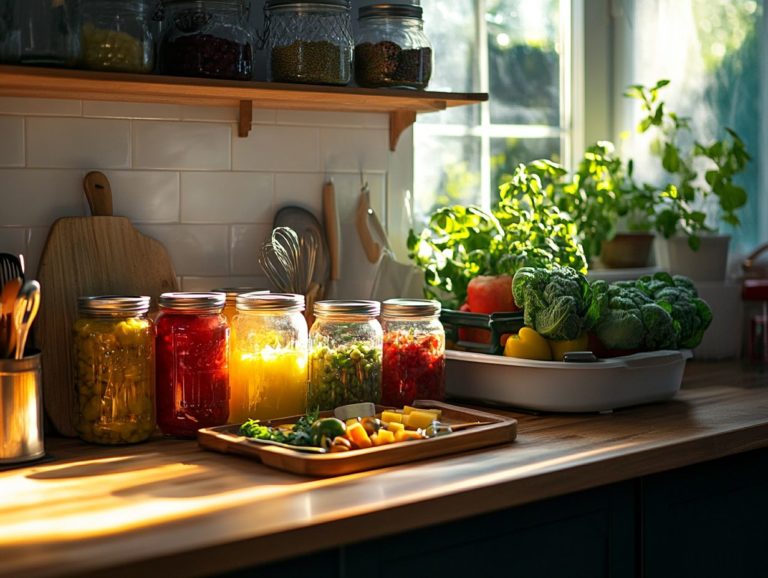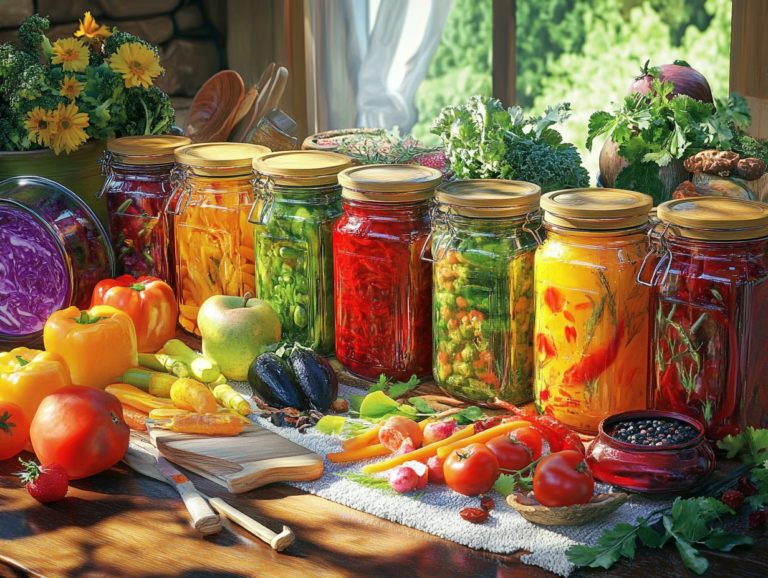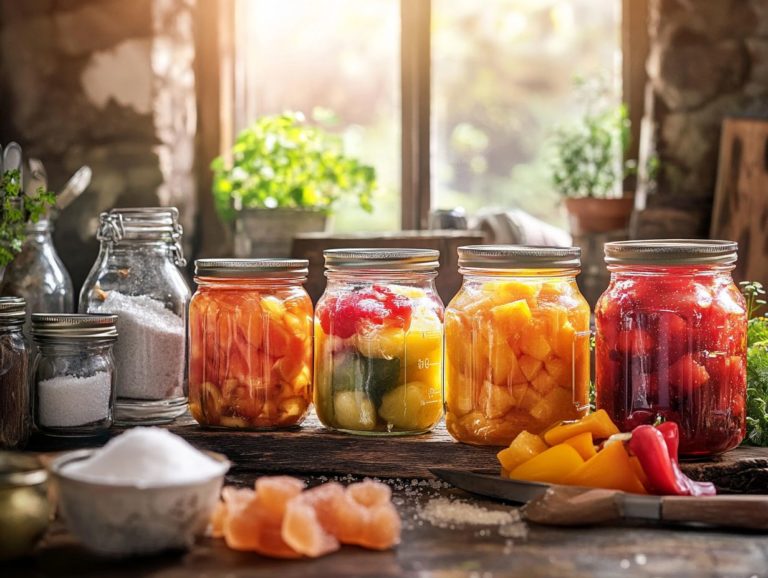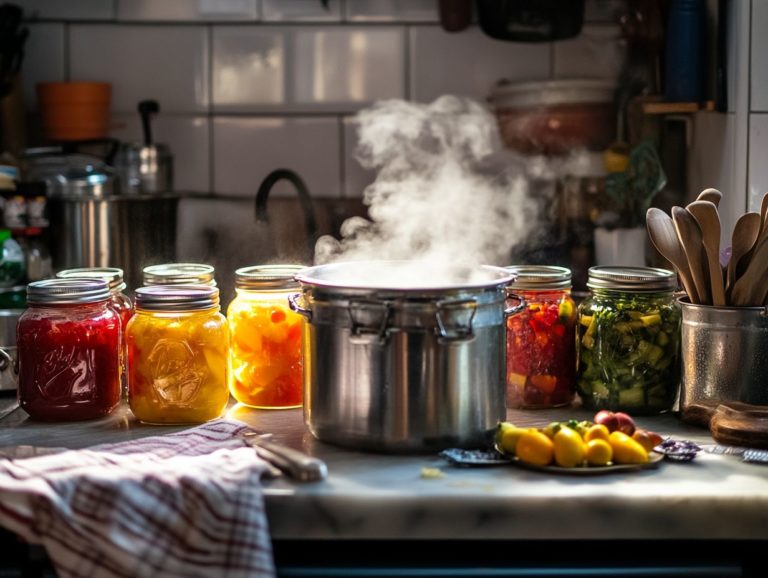Best Practices for Canning Vegetables
Canning vegetables is a time-honored practice that allows you to keep fresh food from your garden or local market, letting you enjoy vibrant flavors throughout the year with methods like home canning and pickling.
This guide covers the essential aspects of canning, highlighting the benefits of preserving nutrients and taste, and guiding you in selecting the finest seasonal produce for your jars.
Discover preparation techniques, various canning methods, and safe storage practices to ensure your canned goods remain delightful and safe from foodborne illness.
Don t miss out on mastering this essential skill and relishing the taste of homegrown goodness make the most out of your vegetable garden!
Contents
- Important Tips for Successful Canning:
- Benefits of Canning Vegetables
- Choosing the Right Vegetables for Canning
- Preparing Vegetables for Canning
- Canning Methods for Vegetables
- Storing and Using Canned Vegetables
- Safety Precautions for Canning Vegetables
- Frequently Asked Questions
- What are the best practices for canning vegetables?
- Why is it important to use fresh produce when canning vegetables?
- What are the necessary steps for cleaning jars and equipment for canning vegetables?
- Is it safe to create my own recipes for canning vegetables?
- How do I know which processing time and method to use for canning vegetables?
- What should I do if my canned vegetables show signs of spoilage?
Important Tips for Successful Canning:
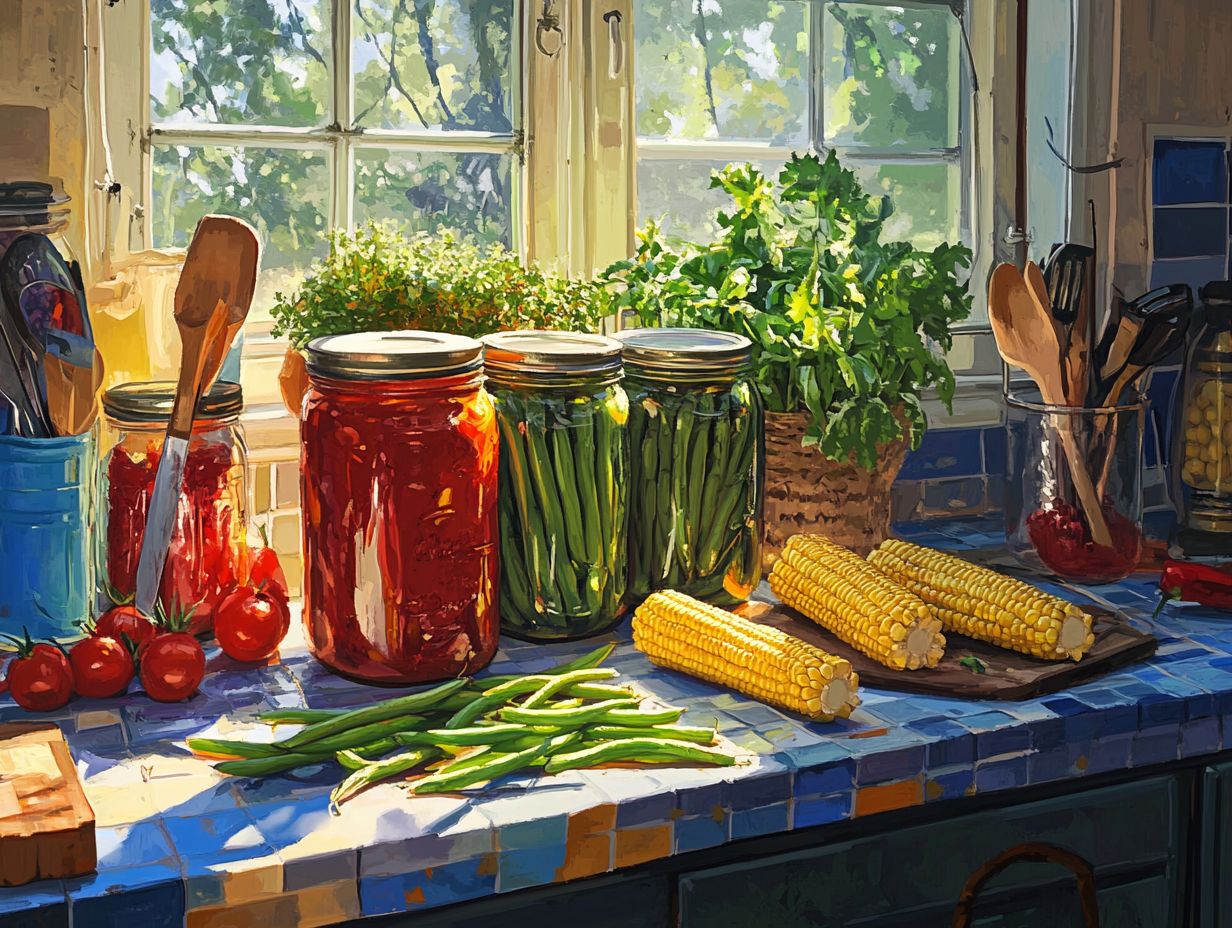
- Preserve nutrients and flavor by canning vegetables, ensuring you have healthy and tasty options even when they are out of season, thanks to proper food storage techniques.
- Choose the right types of vegetables to can, such as high-acid veggies like tomatoes or low-acid ones like green beans, while considering the importance of quality control.
- Follow proper cleaning, peeling, and cutting techniques when preparing vegetables for canning to ensure the best quality and safety of your canned goods, and to prevent botulism.
Why Canning is Your New Best Friend!
Canning is a fantastic method of keeping food fresh that involves sealing fruits and vegetables in glass jars. This effectively prevents spoilage and allows you to savor their flavors long after the harvest season using techniques like vacuum sealing.
Historically, canning emerged in the early 19th century as a clever solution to food storage challenges. It quickly became essential in kitchens worldwide, especially as food preservation methods evolved. Various canning techniques developed during this time; for low-acid foods, pressure canning uses high heat to seal jars, while water bath canning employs boiling water and excels with high-acid fruits and jams.
Following USDA guidelines and research-based methods is crucial. It ensures your food stays flavorful while safeguarding against harmful pathogens and spoilage. By adhering to these safety protocols, including proper lid sealing and jar sterilization, you can relish your preserved delights with complete peace of mind.
Benefits of Canning Vegetables
Canning vegetables offers many benefits that enhance food preservation. You can enjoy seasonal produce throughout the year while keeping its nutritional value and flavors.
By using appropriate canning techniques, such as pressure canning and water bath methods, you create a sustainable way to enjoy fresh vegetables even when they’re out of season, ensuring food safety through safe canning practices.
Preserving Nutrients and Flavor
One major advantage of canning is preserving both the nutrients and flavors of vegetables. This allows you to enjoy their fresh taste long after they ve been harvested. Employ proper canning techniques like using vacuum seals and adhering to appropriate processing times with clean jars to keep essential vitamins and flavors beautifully intact.
As you can your vegetables, heat is applied to eliminate harmful bacteria, yeasts, and molds, significantly reducing the risk of botulism. However, this process can influence vitamin content. For instance, while vitamin C and certain B vitamins are sensitive to heat, the quick processing times used in canning, especially with research-based methods, help minimize their loss.
The airtight seals created during the canning process limit oxygen exposure, which is crucial since oxygen can degrade sensitive nutrients over time. This thoughtful combination of methods not only preserves the nutritional quality but also locks in the vibrant flavors, ensuring that each jar is as close to fresh as possible.
Start canning today and enjoy the delicious rewards all year round!
Choosing the Right Vegetables for Canning
Choosing the right vegetables for canning is vital for successful preservation, particularly through proper cooking techniques and clean jars. You need to be aware that both high-acid and low-acid foods demand distinct processing methods to ensure safety and quality. Familiarizing yourself with canning techniques for pickling vegetables is critical in preventing food spoilage.
It’s essential to understand the unique characteristics of various fresh produce and the corresponding canning techniques to ensure effective food preservation. This knowledge is especially important during the time when many fruits and vegetables are ready to pick, allowing you to maximize the fruits of your labor while utilizing the best canning recipes.
Best Types of Vegetables to Can
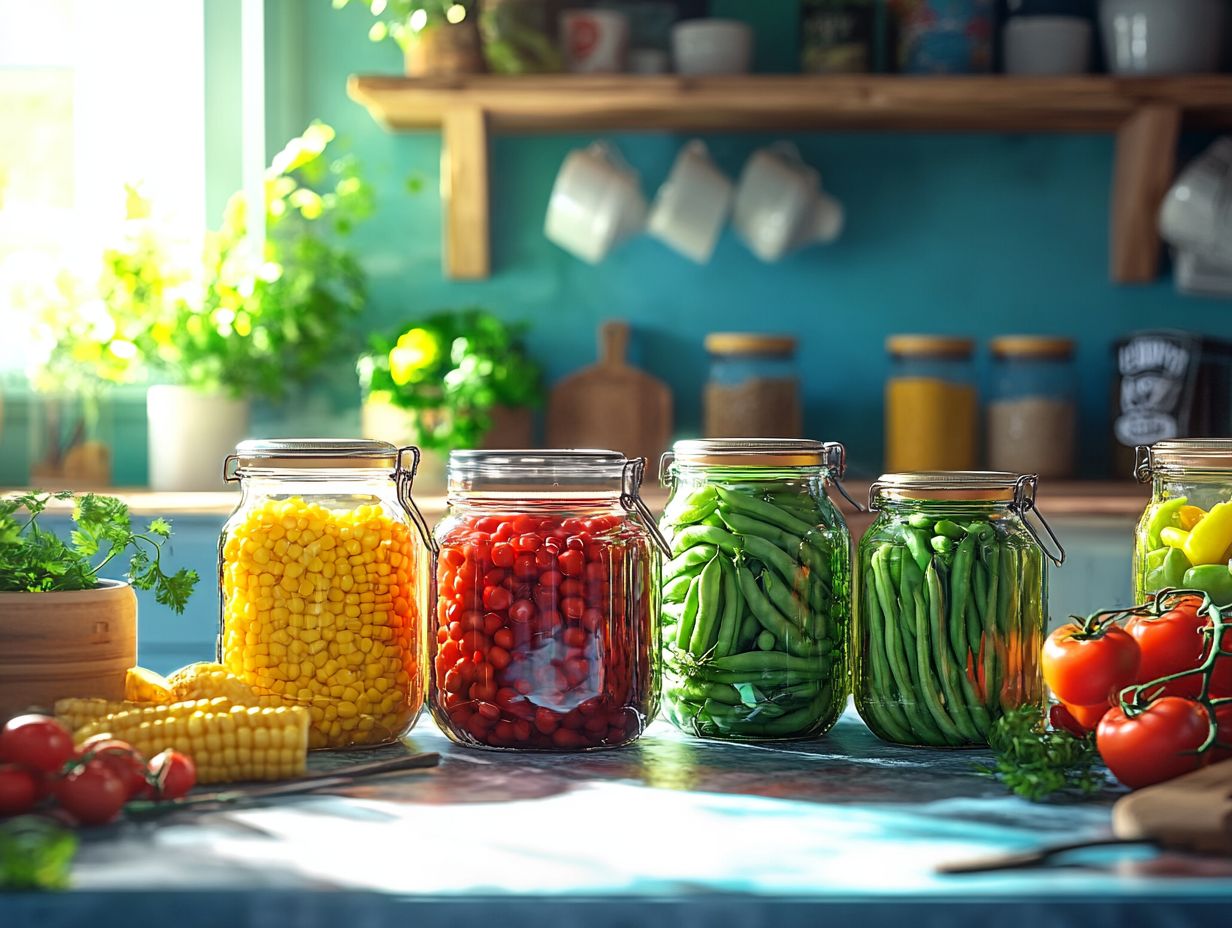
The best types of vegetables for canning include a delightful array of seasonal produce, like tomatoes, green beans, and carrots. Each of these vegetables brings its unique flavors and textures to your preserved goods, elevating your culinary creations with the right recipe instructions. By selecting the right vegetables, you enhance the quality of your canned goods and open the door to a variety of delicious canning recipes that include options for sweetening.
During the summer months, tomatoes are truly at their peak, making them ideal for rich sauces, zesty salsas, and hearty stews. Green beans abound as well, perfect for pickling or preserving in jars with savory spices that pack a punch. Carrots, harvested in late summer and fall, can be canned whole, sliced, or diced, ready to shine in soups and stir-fries throughout the winter.
Don t miss out on delicious options like bell peppers, which add a sweet crunch to your recipes, or zucchini, known for its incredible versatility in both sweet and savory preserves, making them ideal for home canning. Opting for seasonal vegetables enhances flavor and freshness while supporting local farms, giving your pantry a truly artisanal flair and promoting fresh preserving practices.
Preparing Vegetables for Canning
Preparing vegetables for canning involves several crucial steps, including meticulous cleaning, peeling, and cutting techniques that ensure both food safety and the highest quality in your preserved products. For a comprehensive approach, refer to the complete guide to canning mixed vegetables, which utilizes proper cleaning equipment.
By focusing on proper preparation, you eliminate potential contaminants and enhance the overall texture and flavor of the vegetables you plan to can, ensuring foodborne illness is avoided. By paying attention to detail, your preserved foods will be tasty and safe!
Cleaning, Peeling, and Cutting Techniques
Effective cleaning, peeling, and cutting techniques are essential in the canning process to guarantee that your vegetables are free from dirt, pesticides, and harmful bacteria, ensuring food safety. By using clean jars and the right cleaning equipment, you can significantly enhance food safety and elevate the quality of your canned goods while following best practices for canning on a budget.
Start by rinsing your vegetables under cold running water and scrubbing them with a vegetable brush to remove any dirt, a crucial step in preventing botulism. For leafy greens, soak them in a basin of water, then lift them out to leave dirt behind.
Sanitize your cutting boards with a solution of water and vinegar or bleach to prevent cross-contamination, ensuring the highest food safety standards. Investing in a high-quality peeler and knife will allow you to achieve uniform cuts, ensuring even cooking and a pleasing texture in your final product, which is essential for successful food preservation.
Strict hygiene is not just about taste and appearance; it plays a crucial role in preventing the growth of botulinum toxin, a harmful substance that can grow in improperly canned foods, ensuring your eating experience is not only safe but also enjoyable.
Canning Methods for Vegetables
Grasping the various canning methods for vegetables is essential for mastering the art of food preservation, including pressure canning and boiling water bath techniques. Pressure canning and water bath canning are the two primary techniques you ll rely on to guarantee both safety and quality.
Each method has its unique processing times and requirements, so it’s vital to select the appropriate technique tailored to the specific vegetables you wish to preserve. For guidance, refer to this quick guide to safe canning practices using the right canning equipment.
Get started on canning your summer harvest today to enjoy delicious produce all year round!
Water Bath Canning vs Pressure Canning
Water bath canning and pressure canning are your go-to methods for preserving food, each tailored to different types of produce based on their acidity levels. High-acid foods, like fruits and pickled vegetables, are best preserved using the water bath method. In contrast, low-acid foods such as green beans and carrots require the precision of pressure canning to ensure safety and proper preservation.
If you choose the water bath method, you ll need some essential equipment, including a jar lifter for safe handling:
- a large pot with a lid
- a rack to elevate the jars
- canning jars designed for the task
Processing times can vary significantly, ranging from 5 to 85 minutes, depending on the specific food, jar size, and cooking liquid used. Pressure canning requires a pressure canner with a gauge to maintain the correct atmospheric pressure, ensuring optimal safety during the canning process. This method can process food in as little as 20 minutes! However, you’ll need to monitor the pressure levels closely to avoid food spoilage.
It’s crucial to understand the acidity of the vegetables you re working with. This knowledge will guide you in selecting the method that ensures optimal safety and preservation, minimizing the risk of foodborne illness.
Storing and Using Canned Vegetables

Storing and using canned vegetables correctly is crucial for maximizing their shelf life and preserving quality. This ensures that you can savor the fruits of your labor long after the canning process is complete.
Use proper food storage techniques to keep your canned produce safe and delightful. Proper jar sterilization methods will significantly extend the usability of your canned goods.
Proper Storage Techniques and Shelf Life
Understanding the shelf life of canned vegetables and using proper storage techniques is essential for ensuring their safety and quality. Store your canned goods in a cool, dark place and check their condition regularly to prevent spoilage.
Check for signs of damage or bulging in the cans, as these can indicate spoilage or contamination. Regularly inspect labels for expiration dates to remind you of when to consume the products.
Using careful food safety practices like transferring opened cans into airtight containers and refrigerating them promptly will protect the integrity of your vegetables. Proper handling enhances flavor and minimizes the risk of foodborne illnesses, ensuring a wholesome addition to your meals.
Safety Precautions for Canning Vegetables
Safety precautions are essential when canning vegetables. Improper methods can lead to contamination and foodborne illnesses, including botulism. By following canning guidelines for vegetables and using safe handling practices, you can significantly reduce these risks and ensure your canned goods are safe for consumption.
Preventing Contamination and Spoilage
Preventing contamination and spoilage is vital in the canning process to ensure your preserved vegetables remain safe and delicious. Following the best canning practices and using careful food safety measures will significantly reduce the risk of spoilage and harmful bacteria growth.
Be aware of specific contamination risks, such as improper sealing or exposure to air, which can lead to mold growth and fermentation. Watch for signs of spoilage, such as off odors, bulging lids, or discoloration in the jars.
To tackle these issues, use sterilized equipment, heat the jars adequately during the canning process, and store them in a cool, dark place. Regularly check seals and adhere to recommended filling times to maintain the integrity of your preserved goods.
Frequently Asked Questions
What are the best practices for canning vegetables?
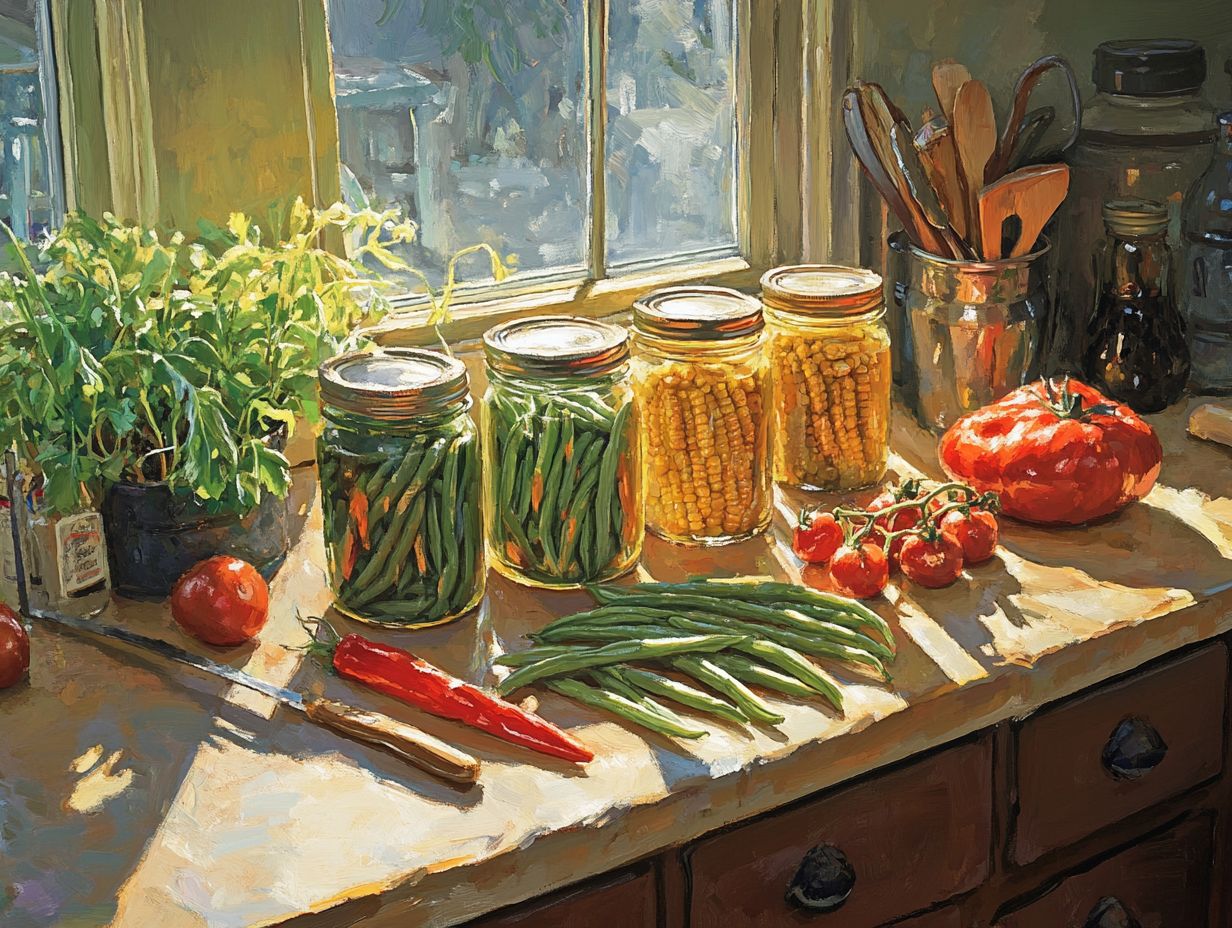
The best practices for canning vegetables include using fresh, high-quality produce and cleaning jars and equipment thoroughly. For more detailed guidance, check out these essential tips for canning vegetables at home. Always follow tested recipes and use the correct processing times.
Why is it important to use fresh produce when canning vegetables?
Fresh produce has the highest nutrients and flavor. It ensures that the vegetables preserve well and are safe to eat.
What are the necessary steps for cleaning jars and equipment for canning vegetables?
Start by washing jars and equipment with hot, soapy water. Rinse them thoroughly, then boil or use a dishwasher to sterilize before use.
Is it safe to create my own recipes for canning vegetables?
Creating your own recipes for canning vegetables is not safe. Always use tested recipes and follow best practices for safe canning equipment use for proper processing and safe consumption.
How do I know which processing time and method to use for canning vegetables?
The processing time and method depend on the type of vegetable, jar size, and your altitude. Refer to tested recipes for specific instructions.
What should I do if my canned vegetables show signs of spoilage?
If your canned vegetables show signs of spoilage, such as bulging lids, unusual odors, or mold growth, do not consume them. Act quickly and dispose of the jars and their contents to protect your health!

